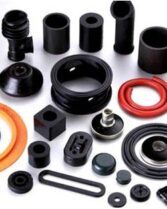Have you ever wondered about the different types of rubber available on the market and how these might be a good choice for your unique requirements? Everyone has different needs when it comes to their choice of materials, and this is no exception with the different types of rubber. Still, if this is something you have been considering, our friendly experts are on hand today to help you find out a little more about the different types of rubber and how these could work for your needs.
What is Rubber?
First of all, we need to first clarify what rubber is and its key properties, generally. Rubber is a solid material that offers exceptional elasticity and tensile strength, making it highly popular for many different applications.
Accordingly, rubber is often used in materials requiring reliable strength with the ability to be flexible. Some common examples of such applications include in rubber dust bellows and seal gasket.
How Many Types of Rubber Are There?
There are numerous types of rubber materials, with approximately forty different varieties. These include both natural rubber materials and synthetic rubber.
It’s well worth considering here that each of these different types of rubber will have unique manufacturing processes, and these hence provide numerous different properties. As such, defining what rubber is most useful is not necessarily a straight forward process since this may depend on how you intend to use the rubber.
Natural Rubbers
Natural rubbers are produced naturally by plants and tend to be incredibly soft and wear resistant . They offer excellent elasticity and are useful in many different molds and products.
Synthetic Rubber
Synthetic rubber materials offer excellent tensile strength and also come with the additional benefit of usually being non-allergenic. Accordingly, synthetic rubber materials are commonly used in applications requiring more specific characteristics and in scenarios whereby natural rubber latex causes allergic reactions. Synthetic rubber is made from petrochemicals in laboratory settings.

The Main Types of Rubber
At this point, we’ve briefly considered how many types of rubber there are. But what are some of the most common and popular types of rubber? Well, the following could all be excellent options in this regard.
NR (Natural Rubber)
When we think of rubber materials, natural rubber is one of the first options that comes to mind. Natural rubber is derived from latex materials produced by numerous plants in response to an incision. Natural rubber materials are strong, soft, and wear resistant, making them popular in many different applications. They are also relatively simple to create.
Natural rubber materials offer relatively good temperature stability, often being stable between -60 degrees Celsius and +70 degrees Celsius. While this makes natural rubber materials less suitable for incredibly high-intensity applications, for the majority of scenarios, natural rubber is more than capable of withstanding all manner of uses.
Similarly, natural rubber is also relatively resistant to chemical exposure, which makes it popular for use in educational environments and with mild chemical processing. However, it is important to recognize here that natural latex rubber is not suitable for use with solvents, fuel, and mineral oils; in such scenarios, many other materials will be better suited overall.
Natural rubber is often combined with a very small proportion (5%) of synthetic materials to make Linatex rubber, a unique product that is extremely wear resistant and provides superior resistance for heavy-duty rubber material applications. Mining industries, for example, often use Linatex rubber as part of their applications.
Silicone (VMQ)
Silicone rubber is one of the most common alternatives to traditional natural rubber materials for use in applications where latex causes allergic reactions. Silicone rubber is also incredibly malleable and highly biocompatible for many different needs in industrial applications and daily use.
FKM (Viton)
Commonly known as Viton, or fluoride rubber, FKM rubber is highly resistant to many different chemicals and offers exceptional temperature stability up to 250 degrees Celsius. FKM rubber is commonly used in chemical processing and handling thanks to these excellent properties overall.
EPDM
EPDM rubber stands for “ethylene propylene diene monomer.” This form of synthetic rubber is highly resistant to acids, ultraviolet light, and ozone, as well as radiation. It is also considered the highest form of food-safe rubber on the market, ensuring that food processing facilities can use the material effectively in their own manufacturing processes.
NBR (Nitrile)
Nitrile rubber, sometimes also known as “nitrile butadiene rubber,” is an incredibly popular form of rubber material commonly used in automotive use thanks to its excellent oil and wear resistance. NBR is often seen in engine components, although it can also be used in some medical grade rubber products alongside silicone materials.
CR (Neoprene)
Neoprene rubber is one of the earliest-created forms of synthetic rubber materials, making it one of the most popular different types of rubber used in the modern market. It’s incredibly unique for its resistance to heat, which means that it does not readily burn; moreover, neoprene does not degrade or corrode easily, further adding to its value overall.
SBR (Butadiene Rubber)
SBR rubber is one of the world’s most commonly produced forms of synthetic rubber. SBR rubber offers excellent water and glycol resistance while offering brilliant durability. In line with this, it’s worth noting that SBR rubber is particularly highly regarded in the transportation industry.
Final Thoughts
If you’ve been wondering about the different types of rubber and what rubber is most useful, it’s critical to consider the key properties of each option to help inform your decision. Fortunately, though, this shouldn’t be a major challenge since there are plenty of excellent rubber materials that can meet each different requirement.
As such, it’s never easy to answer questions about “what is the best quality rubber” since this will largely depend on your personal goals. Nevertheless, we’ve outlined everything you need to know today to help you find out a little more about what rubber is most useful for your unique requirements.




